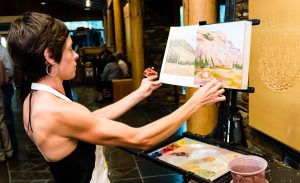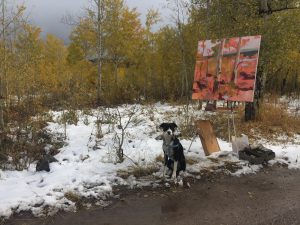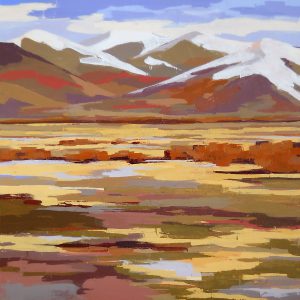By Kari Mauser

Hadley Rampton, winner of the Jury’s Choice Award at the High Desert Museum’s 2018 Art in the West exhibition for her work “Vista,” blends her love of the outdoors with her passion for art through plein air painting. Born in Salt Lake City in 1975, Rampton grew up exploring the Utah wilderness and the Teton/Yellowstone area, a place she has always loved and continues to wander today, along with her trusty Border Collie, Phoebe, who plays while the artist paints.
When did you know you wanted to be an artist and what influenced that path?
I’m one of those who can’t remember when I wasn’t creating art — drawing or painting. As a little girl I loved creating art, mostly drawing. When I was 9, seeing this interest of mine, my mother put me in art classes outside of regular school — at the Visual Art Institute in Salt Lake City, Utah. With that, I was able to begin oil painting and figure drawing by the time I was 12, and I just loved working with more professional and advanced media. I loved it so much so I would just do it. It made me happy. And I was always interested in drawing accurately, drawing from life. I would actually be jealous of those kids who were drawing more from imagination. Even though I could draw more accurately, I was jealous because I didn’t have quite the imagination that they did.
Where do you find your ideas and inspiration for your pieces?
I love being outside. For me it’s these two loves and being able to combine these two things. I definitely do the majority of my work outside. It can get difficult, but I love the feeling of the elements around me, it energizes me. Maybe that is why my colors tend to be a bit more intense, and also my brush strokes and with my palette knife … I tend to just put down the color and then the next color and not labor over it too much. Being outside, because the light is changing and everything is moving and there’s all this energy around me, I can’t fuss over things. Being outside also allows me to really focus. Up in the mountains by myself, out in nature, that’s it. I’m there. I’m painting. I’m not doing anything else. There is nothing else to distract me.
Do each of your pieces represent specific places or landscapes?
I love to explore. If I wasn’t an artist I would be an explorer. Most of the places I paint I have been to many times, they’re places around where I live — mainly in the Northern Utah mountain ranges, Southern Utah, the Tetons and into Idaho, but I’ve never been south of Utah painting. When I am in a new place, I’m not sure what I’ll be painting. I just head out and look for things that really strike me. I love to venture into new territory, but also to revisit old territory and look at it in different ways and maybe from a different angle or with a different perspective.

I’ve come to love painting aspen trees. I have taken a bit more of a still life approach in a way because I am really thinking of the subtleties of composition and placement on the canvas. It’s a different thing than when I paint a distant landscape … the way the trunk curves, especially in the white, the shadows, the various colors that emerge, I emphasize those. I investigate that on much more of an intense level.
With the more distant landscape pieces, the location becomes more relevant. I always paint from life, but I am not too worried about making my paintings look exactly as the scene looks. I love letting what I’m feeling play a role, and because I work quickly there is a lot of gesture in the work, so things aren’t exact and that’s okay. In some ways, I hope that by working that way the feeling of the place comes through even more, much like a gesture drawing of a person — it may not be anatomically accurate, but it can convey the personality and the feeling of that person.
Do you still paint people?
For the longest time that is what I loved most. Through college I painted and drew the human figure quite a lot. Now I’ll go to a coffee shop and I’ll sketch the people as they’re moving, again carrying on with that immediacy and going with the gesture. When I travel overseas and take my watercolors, I paint street scenes and the people … just as I’m wandering, the scenes that I come upon. It’s like how I work here — just exploring and coming upon something that captures my desire to paint. It’s a different subject when I’m traveling overseas, but it’s that same sort of philosophy.
Do you consider yourself a historian, capturing time through your art?
I love history, and I think that’s especially true with the painting during the travels I do overseas. Where I go, what I see … I am generally always thinking about history and wanting to learn more by being there. With my paintings, especially of street scenes, I am really drawn to wear and tear where you can feel the history and the passage of time rather than everything being perfect. It’s also culture that I love to capture. At one point I had the privilege of being in Istanbul, and talk about history! I was able to paint these mosques and the Hagia Sophia, and the fun of it was there’d be a woman in a full burka and another woman in complete Western dress — shorts and a tank top. That’s the culture of Istanbul, they have this incredible history and then they have the whole Muslim component and then it’s also modern. I love capturing things like that, that tell, through visual means, a story, that tells so much about the place.
What are some of the most unique or noteworthy places you’ve been able to capture with your paintbrush?
It’s actually hard for me to rank places because even the places that I’ve gone that aren’t that far off the map have been incredible. I tend to be drawn to wandering and coming upon things. So even in a place that is more familiar, such as Paris, I find little moments that might be surprising. And the same is true for landscapes. I’ve painted iconic places like the Tetons, but then also have had the opportunity to venture down into the back areas that are not as known.
Do you always work with the same color palette?
My palette is very limited, so I do a lot of mixing. I have a blue, a version of red, a brown, a yellow and a white, no black, and from there I mix. Through the seasons, the color palette of the painting changes even though I’m working with the same paint colors. Then of course it varies from when I’m working in southern Utah in the redrock desert versus more northern alpine environment. So I do respond to the colors around me in real life, but sometimes it’s much more vibrant than what it really is, and other times it’s accurate to what it is. When I’m painting, I’m not really thinking about it, it’s just happening.

Congratulations on your Jury’s Choice Award for this year’s Art in the West exhibition. What inspired “Vista,” what does the piece represent and what was the process of creation?
“Vista” — that piece is painted in the Park City area near Salt Lake in a spot I had not painted before. I had felt like doing something with a bit more distance. It was the beginning or middle of March so there was still some snow in the upper mountains, but there was also the wonderful warm hues that emerge when the snow melts. I found it while driving in the area — I just pulled over and it felt right so I set things up. With that one, I returned to the same place at the same time of day for several hours over a period of several days. It has a stylized, abstract feel to it. As I painted, I began loving the patterns and colors that were emerging. It was such a different piece. When that happens, when I paint a piece that is so different, just like anything at first, I’m not sure how I feel about it. But with this one, I came to really love it!
How has your art evolved?
For many years it was me yearning to draw accurately, but then ironically by the time I got to college I was inspired by the loose manner in which I saw others painting and drawing. I wanted to be more emotional, to let it go so that what happens happens. That is where I am now, and it is much more fun for me to be loose and let the emotion enter.
How do you know when you’re finished with a piece?
It’s hard to explain, but when it’s done it’s done. It’s a feeling, that last stroke, and I step back and just know.
